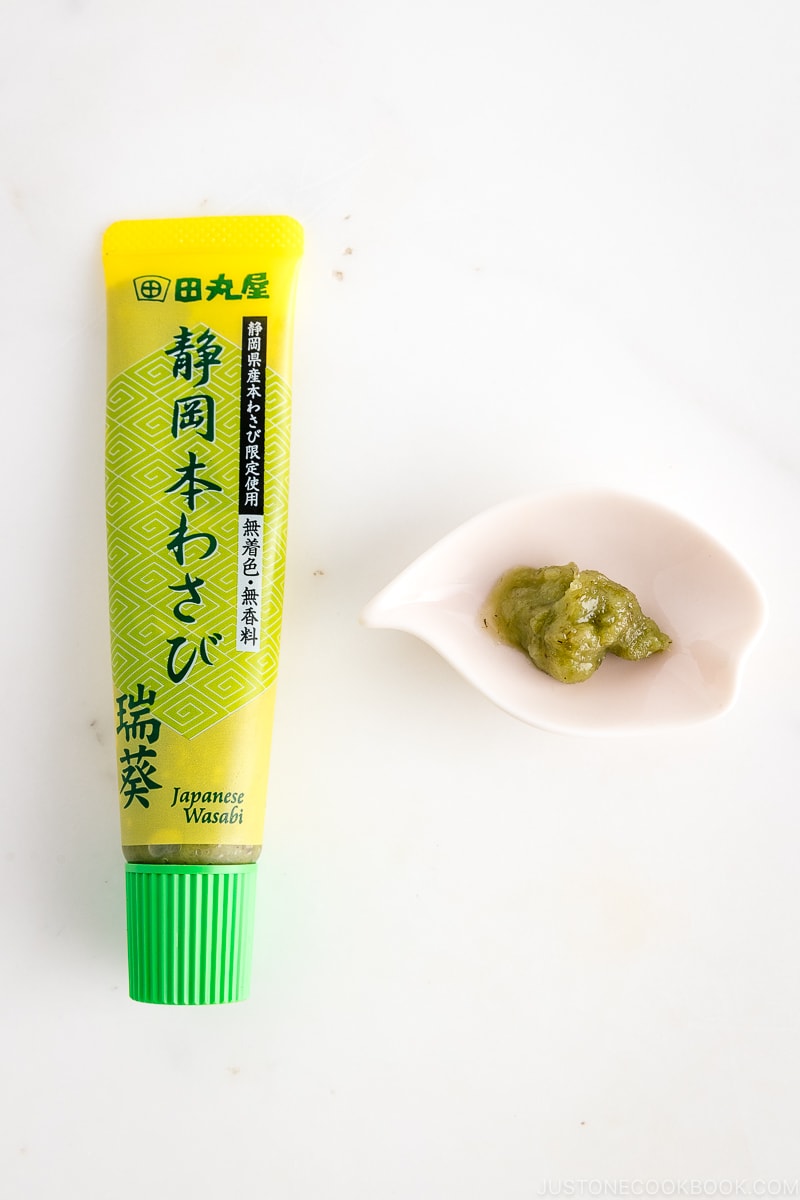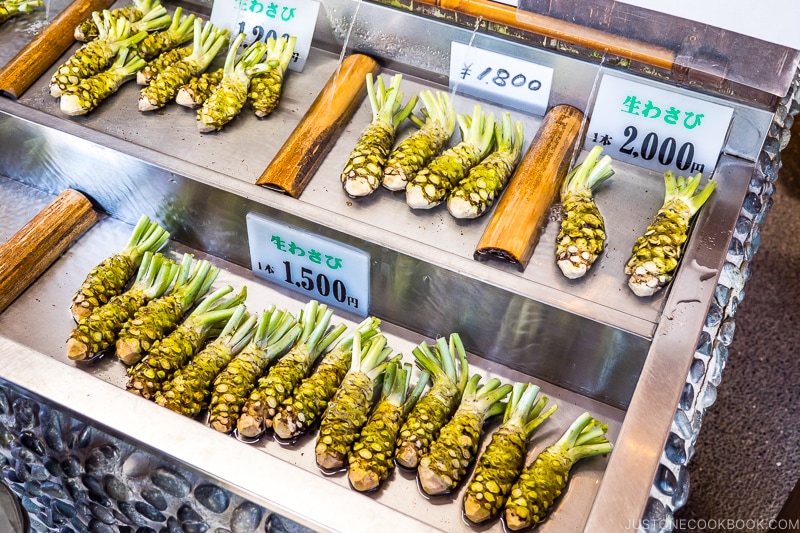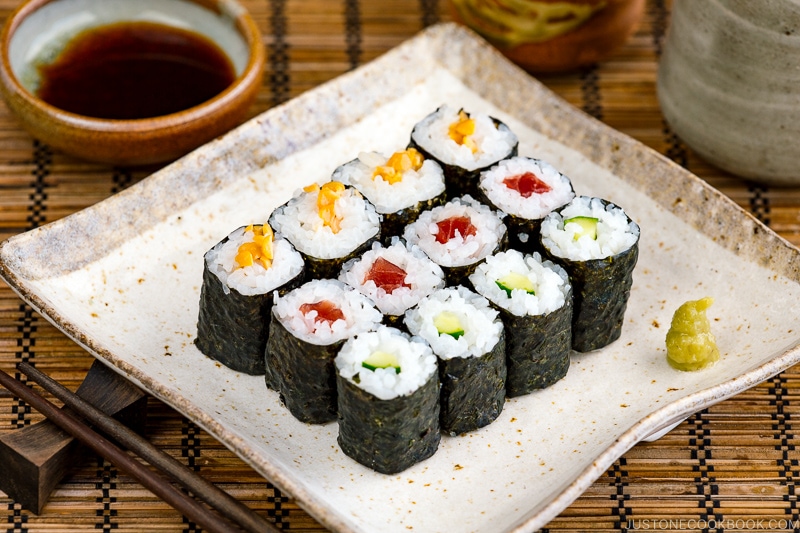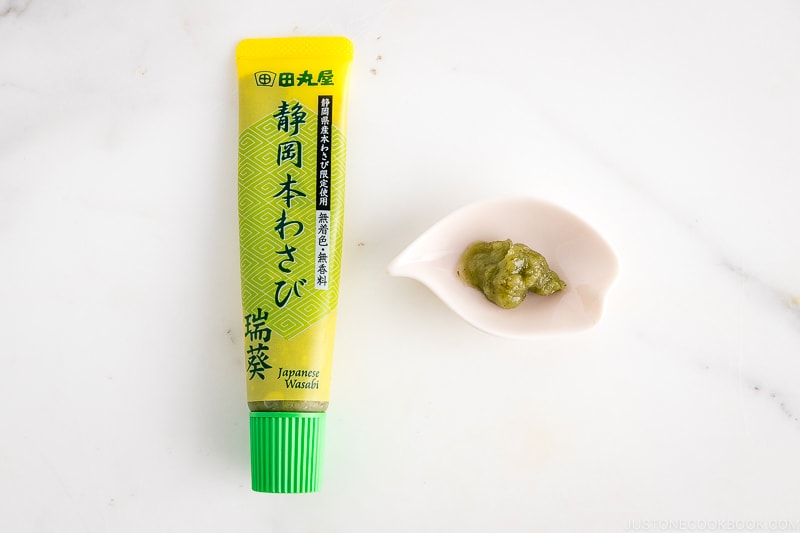Pungent and spicy, wasabi, also known as Japanese horseradish, is eaten with sushi, sashimi, and other dishes. Let’s look at this intriguing plant and its fiery, nose-tingling flavor.

Wasabi (山葵, わさび) is the spicy green paste served as a condiment to sushi and in some Japanese dishes. Real wasabi is made from the rhizome of the Wasabia japonica or Eutrema japonicum plant of the Brassicaceae mustard plant. While it resembles a root, we eat the plant’s stem.
It’s native to Japan and grown commercially in southwest China, Taiwan, Korea, and the United States.
Read about the JOC family’s visit to a wasabi farm in Azumino, Nagano prefecture.
Table of Contents
What Is Wasabi?
The wasabi plant resembles a short green root. It’s commonly used by grinding it into a fine paste and used as a condiment for sushi, raw fish, soba noodles, steak, and other dishes. The entire plant is edible, including the root, stem, leaves, and flowers.
Wasabi dates back to the eighth century and was used as medicine for its antibacterial properties to prevent food poisoning. Wasabi cultivation began in the early Edo period (1604-1867).
Wasabi grows wherever an abundance of fresh mountain water is available. The regions famous for wasabi include Shimane, Nagano, and Shizuoka prefectures.

What Does Wasabi Taste Like?
Fresh wasabi paste is a treat. It tastes bright and fresh with a hint of a quickly fading sting. It is intense yet delicate enough to let the flavor of raw fish shine.
This characteristic sting is due to the chemical compound allyl isothiocyanate, also found in mustard and horseradish. But the burning sensation is much shorter than the fiery spiciness of chili peppers. To describe the difference, wasabi burns your nasal passages while chili peppers burn your tongue.
You may encounter real Japanese wasabi at high-end sushi restaurants and Japanese restaurants. Wasabi served with sushi highlights the fish’s flavor, not to overwhelm it (FYI, do not ask for more wasabi at a sushi bar. Real wasabi is expensive, and it’s also an insult to the sushi chefs crafting the perfect balance of fish and spice. Read more about Japanese dining etiquette here).
Most of the wasabi you may encounter, including wasabi in tubes, powder form, and small packets, is horseradish with green food coloring and thickening agents like cornstarch. Although there are some wasabi tubes with real wasabi paste mixed in, check the label. A sure sign of imitation wasabi is an immediate burning sensation in the nose and a uniform green color and pasty texture. If you find the real deal at a restaurant or supermarket, consider yourself lucky!

How To Use
Tube wasabi and powdered wasabi are the most accessible forms of wasabi. Store the opened tube wasabi in the refrigerator. Try to find ones with real wasabi.
To make the paste from powdered wasabi, mix it with water to reconstitute it into a paste. Most powdered wasabi does not include wasabi and is a combination of mustard, horseradish, and food coloring. But it has a long shelf life and is fine if you occasionally use it.
Real wasabi is expensive, whether imported from Japan or cultivated elsewhere. It’s susceptible to open air and will lose its flavor in 15 minutes. Putting a smear of wasabi under the cut of fish for sushi prevents oxidation. Sushi masters will grind wasabi per order and will never make a batch. If you see a pile of green paste, it’s fake wasabi.

Recipes Using Wasabi

- Japanese Cold Tofu (Hiyayakko) 冷奴
- Zaru Soba (Cold Soba Noodles) ざるそば
- Best Sushi Recipes to Make At Home (How to Guide)
Where To Buy
You can find tube and powered wasabi at Japanese and Asian grocery stores and many conventional supermarkets. You may be able to find real wasabi at high-end or Japanese grocery stores.
I recommend this wasabi, which you can find on Amazon.
How To Choose The Best Wasabi
It’s OK to buy a tube or powered wasabi. It’s convenient and much more affordable, after all! Just check the label and see if you can buy those with real wasabi. It’ll say “hon-wasabi” or “nama-wasabi” on the label, which means it contains at least 50% real wasabi.
Choose fresh and unshrived stems that are thick and firm. Bigger does not necessarily mean better, so choose the size that fits your purpose.
How To Store
Store powdered wasabi in a cool, dark place with low humidity, like your spicy cabinet. You can keep tube wasabi in the refrigerator.
For fresh wasabi, wrap it in dampened paper towels and put it in a plastic bag. Check on it occasionally when not in use, and change the paper towel. If necessary, trim away any black spots. It won’t keep indefinitely, so use it quickly.
Substitutions
Powdered or tube wasabi are the best substitutions for real wasabi.
Health Benefits
Wasabi’s antioxidants and anti-bacterial effects have been known for centuries, safeguarding Japanese diners without knowing how and why. It contains naturally occurring compounds that have antibacterial properties against certain foodborne illnesses. It also has anti-inflammatory properties, suppressing cells and enzymes promoting inflammation. It also contains cancer-fighting properties and can boost the immune system.
It also contains vitamins B, C, and A and minerals such as calcium, magnesium, and potassium. It’s low in cholesterol and sodium. While it’s not high in nutrients, it’s usually served with highly nutritious fish and seafood.
FAQs
Q: Why is real wasabi so expensive?
Real wasabi is expensive because the wasabi plant is extremely difficult to grow commercially and in greenhouses. Cultivating requires specific conditions: a clean flow of water, shade, temperature between 8-20C/46-68F, and their stems partially submerged in water. That’s why the majority of the wasabi out there is fake wasabi.
Q: Is fake wasabi spicier than real wasabi?
Yes, fake wasabi tends to be much spicier than real wasabi. The taste of real wasabi tends to be subtle compared to fake wasabi. Plus, horseradish has a more potent sting.
Q: Where can I order fresh wasabi online?
You can order fresh wasabi online from Whiskey Hill Farms if you are in the US.
Wish to learn more about Japanese cooking? Sign up for our free newsletter to receive cooking tips & recipe updates! And stay in touch with me on Facebook, Pinterest, YouTube, and Instagram.










Hi Nami
I have a question about wasabi paste and wasabi powder. I have some recipes for wasabi mayo that call for wasabi paste, some that call for wasabi powder. What’s the ratio between the two? For example, I have a recipe that calls for 1/2 tablespoon of wasabi powder, but all I have is paste. How would I substitute my paste for the powder in this recipe? Should I double the paste, half it? What’s the ratio formula between the two. Thanks.
Hi Kazy, Thank you very much for reading Nami’s post!
It depends on the type of dish, you might not be able to replace the powder form with paste.
Normally, 4 teaspoons full of wasabi powder make 4 servings (1 teaspoon x 4) of wasabi paste.
We hope this helps!
Hi Nami!
I have a question about wasabi. I bought 3 wasabi plants from our local nursery and so far they are growing happily in a shady spot in the garden. Yesterday I harvested the first leafs and put them into my miso soup, it was delicious!
Do you have any other suggestions/recipes for wasabi leafs and stems? They are quite pleasant in taste and can be harvested long before the root is ready to harvest – but because of their unique flavour I find it hard to pair them with any dishes I know other than miso soup.
I tried to pickle some stems but they turned out quite bitter
Hi Lilly, Thank you very much for reading Nami’s post! We are so happy to hear you are growing Wasabi at home! Awesome!
We currently don’t have the wasabi leaves and stems recipe on the site, but you can try these methods:
* Make Ohitashi – https://www.justonecookbook.com/spinach-ohitashi-japanese-spinach-salad-with-bonito-flakes/
* Saute them with oil
* Dipped in the Tempura batter, and deep fry – https://www.justonecookbook.com/tempura-recipe/
We hope this helps!